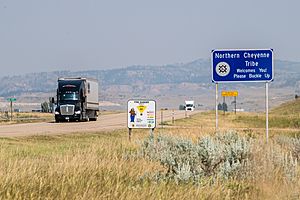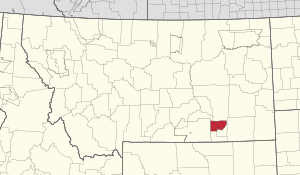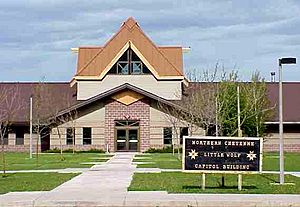Northern Cheyenne Indian Reservation facts for kids
Quick facts for kids
Northern Cheyenne Tribe of the Northern Cheyenne Indian Reservation
Tsėhéstáno
|
||
|---|---|---|

Welcome sign
|
||
|
||

Location of Northern Cheyenne Indian Reservation
|
||
| Country | United States | |
| States | Montana, South Dakota | |
| Established | 1884 | |
| Population
(2013)
|
||
| • Total | 4,939 | |
| Time zone | UTC-7 (MST) | |
| • Summer (DST) | UTC-6 (MDT) | |
The Northern Cheyenne Tribe (also called Tsėhéstáno in their own language) is a Native American tribe. They are officially recognized by the United States government.
Their home is the Northern Cheyenne Indian Reservation, located in southeastern Montana. This reservation is about 690 square miles, which is larger than many cities! Around 5,000 Cheyenne people live here. The main offices for the tribe and government are in Lame Deer, Montana. This town also hosts the yearly Northern Cheyenne pow wow, a special gathering with dancing and celebrations.
The reservation has natural borders. The Tongue River is to the east, and the Crow Reservation is to the west. There are also some smaller pieces of land in South Dakota that belong to the tribe. The reservation is about 40 miles east of where the famous 1876 Battle of the Little Bighorn took place.
As of 2013, there were over 10,000 enrolled tribal members. About half of them lived on the reservation. Most people living on the reservation are Native American, and many speak the Cheyenne language. Some members of the Crow Nation also live there.
Contents
The Cheyenne People and Their Culture
The Cheyenne people have a deep spiritual connection to their land. They see places like Bear Butte as sacred. Many Cheyenne work as foresters and firefighters, caring for the land. This strong connection to nature is important in communities like Lame Deer and Birney.
There are many interesting places in the Ashland area. These include a historic buffalo jump (where buffalo were hunted), burial sites of Cheyenne chiefs, and the spot where Custer camped before the Battle of the Little Bighorn. You can also visit the Cheyenne Indian Museum and the St. Labre Indian School. The Ashland Powwow is another exciting event.
A Difficult Journey North
The Northern Cheyenne are related to the Southern Cheyenne, who live in Oklahoma. After wars in the 1870s, like the Black Hills War, the Northern Cheyenne were forced to move to Oklahoma. They had to live on the same land as their southern relatives.
Life in Oklahoma was very hard for them. The weather was too hot, and they were forced to farm instead of hunting and gathering as they traditionally did. Many people became sick and died. In 1878, a small group bravely left Oklahoma and traveled north. This long and difficult journey is known as the Northern Cheyenne Exodus.
After their journey, the Northern Cheyenne settled near Fort Keogh in Miles City, Montana. In the early 1880s, many families moved south to the Tongue River area. They made their homes in the northern part of the Powder River Basin, which they considered their true homeland. The Northern Cheyenne were allies with the Lakota during the 1876–77 Black Hills War.
Establishing the Reservation
The United States government officially created the Tongue River Indian Reservation. This happened through an order from President Chester A. Arthur on November 16, 1884. The reservation first covered about 371,200 acres.
At first, the reservation did not include all Cheyenne families. Some had settled further east near the Tongue River. The St. Labre Catholic Mission helped these families. Later, on March 19, 1900, President William McKinley made the reservation larger. It was extended to the west bank of the Tongue River, growing to over 444,157 acres. The Cheyenne families who lived east of the Tongue River then moved to the new reservation lands.
Communities on the Reservation
Lame Deer, Montana is the capital of the Northern Cheyenne Nation. It has about 4,000 residents, and most are American Indian. Chief Dull Knife College is located here.
To the west is Muddy, Montana, with about 600 residents. Most people here are American Indian. Further west is Busby, Montana, with about 700 residents. The Tongue River Boarding School opened in Busby in 1904. The school's basketball team became famous. They even won a game against the Harlem Globetrotters and a State championship in the 1950s!
Ashland, Montana is to the east. The St. Labre Indian School, a Catholic boarding school, was started there in 1884. About 75% of Ashland's 460 residents are American Indian. They also have a strong basketball tradition.
Birney, Montana is south of Lame Deer and Ashland. It has about 100 residents, mostly American Indian. Part of Birney, called "White Birney," is just south of the reservation.
Colstrip, Montana is a nearby city known for coal mining. It is about 20 miles north of the reservation. Some Cheyenne people attend public school or find jobs in Colstrip.
Education on the Reservation
Chief Dull Knife College is a tribal community college in Lame Deer. It is open to all students and helps many go on to four-year colleges. The college is officially recognized and is a member of important education groups.
The Northern Cheyenne Tribal School is another important school on the reservation.
The reservation also received a special grant in 2010. This grant from the United States Department of Education helps support programs like the local Boys & Girls Clubs of America.
The St. Labre Catholic boarding school serves children from pre-kindergarten to 12th grade. It teaches nearly 450 students. The school combines formal education with Cheyenne culture and Catholic faith. It also runs a youth group home, childcare center, and community services. There is a St. Labre museum that displays important Cheyenne artifacts. It helps people learn about the culture and language.
Notable Northern Cheyenne People
| Name | Birthdate | Notability | Reference |
|---|---|---|---|
| Joseph Fire Crow | 1959-2017 | Northern Cheyenne, famous flutist and recording artist. He was nominated for a Grammy Award and won a Nammy. | |
| Eugene Little Coyote | Northern Cheyenne, former Northern Cheyenne president. | ||
| Little Wolf | ca. 1820–1904 | (In Cheyenne: Ó'kôhómôxháahketa, meaning Little Coyote) He was a Northern Só'taeo'o chief and a Sweet Medicine Chief. He was part of the "Old Man" chiefs in the Council of Forty-four. | |
| Roman Nose | 1823-1868 | (In Cheyenne: Woo-ka-nay) A legendary war hero and chief of the Elk Horn Scrapers. | |
| Two Moons | 1847-1917 | Northern Cheyenne Chief. Also known as Éše'he Ȯhnéšesėstse, Ónonevóo'xénéhe – "Ree Roman Nose" or Mȧsėhávoo'xénéhe – "Crazy Roman Nose". | |
| Rynalea Whiteman Pena | Former Chief. | ||
| Wooden Leg | 1858–1940 | Northern Cheyenne warrior who fought at the Battle of the Little Bighorn. | |
| Marie Sanchez | 1939-2019 | Chief Judge, human rights activist for Indigenous people, and linguist. |



